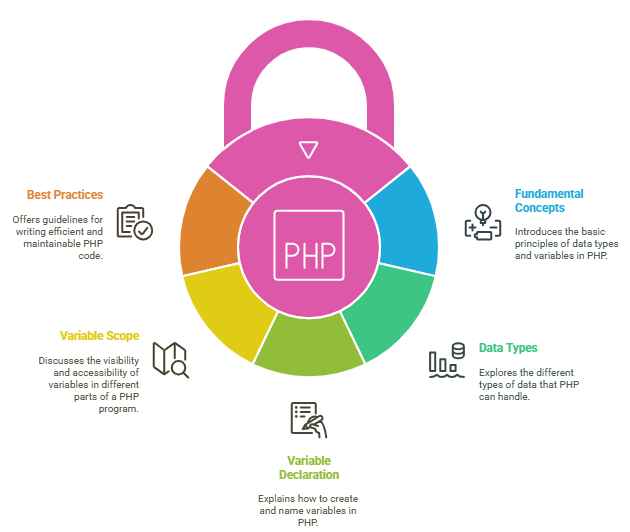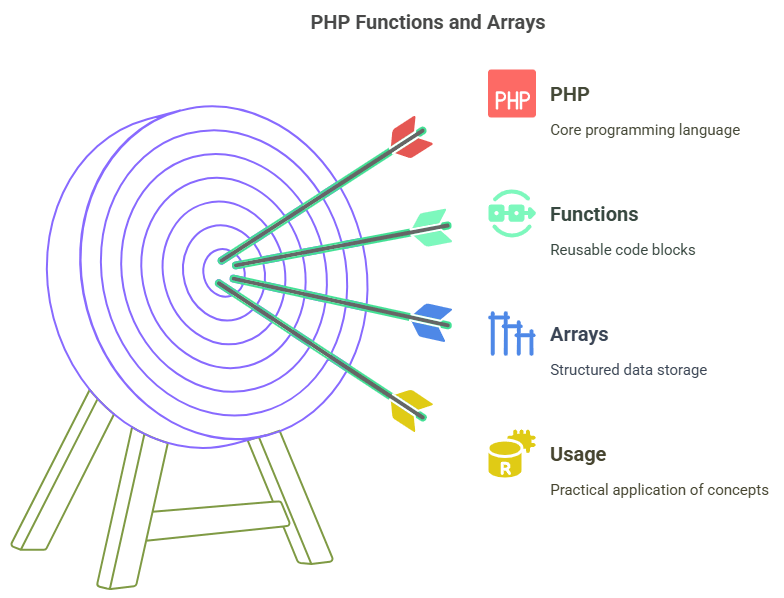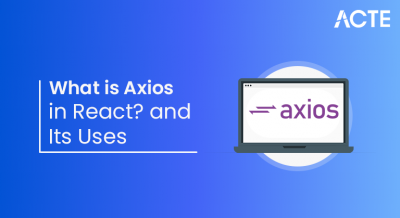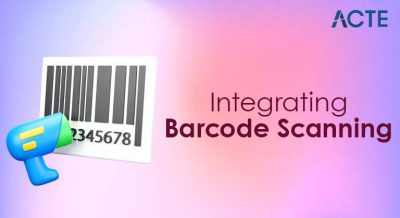
- Introduction to PHP
- Data Types and Variables
- Control Structures
- Functions and Arrays
- Form Handling
- File Handling in PHP
- Working with Databases
- PHP Frameworks
Introduction to PHP
PHP (Hypertext Preprocessor) is a widely-used, open-source server-side scripting language designed primarily for web development, though it also serves as a general-purpose programming language. Originally created in 1994 by Rasmus Lerdorf, PHP has evolved into a powerful and flexible language that powers millions of websites and web applications worldwide. One of PHP’s key strengths lies in its ability to be embedded directly within HTML, making it easy for developers to add dynamic features to static web pages. When a PHP script is executed on a server, it processes data, interacts with databases, and performs back-end logic before sending the resulting HTML to the client’s web browser, topics covered in Web Designing Training. PHP supports a wide range of databases, including MySQL, PostgreSQL, and SQLite, which makes it ideal for building database-driven websites. It also provides robust session management, file handling, and form processing features. Whether you’re creating a simple contact form or a complex content management system, PHP offers the tools needed to get the job done efficiently. PHP is platform-independent, meaning it runs seamlessly on operating systems like Windows, Linux, Unix, and macOS. It integrates well with popular web servers such as Apache and Nginx and is supported by numerous hosting providers, which makes deployment straightforward. Many major platforms such as WordPress, Joomla, and Drupal are built with PHP, highlighting its role as a foundational technology in modern web development. Its ease of use, extensive documentation, and large community contribute to PHP’s ongoing popularity and relevance in the development world.
To Earn Your Web Developer Certification, Gain Insights From Leading Data Science Experts And Advance Your Career With ACTE’s Web Developer Courses Today!
Data Types and Variables
In PHP, data types and variables are essential components that enable developers to store and manipulate information efficiently. A variable is a named container used to hold data and is defined using the dollar sign symbol ($) followed by the variable name. PHP is a loosely typed language, meaning it automatically determines the data type based on the value assigned to the variable, without requiring explicit declarations. PHP supports various data types, which are mainly categorized into scalar, compound, and special types, similar to how AngularJS CDN Integration handles different modules. Scalar types include integers for whole numbers, floats (or doubles) for decimal numbers, strings for sequences of characters, and booleans for true or false values. Compound types consist of arrays, which can store multiple values in a single variable, and objects, which represent instances of user-defined classes. Special types include NULL, which represents a variable with no value, and resources, which are references to external resources like database connections.

Variables in PHP are case-sensitive and must begin with a letter or an underscore, followed by any number of letters, numbers, or underscores. The flexibility of PHP variables allows them to change type dynamically during program execution, offering greater convenience in handling different kinds of data. Understanding how PHP manages data types and variables is crucial for building functional, error-free applications, especially when working with user input, performing logical operations, or connecting to databases.
Control Structures
- If Statement: The if statement is the simplest control structure in PHP that executes a block of code only when a specified condition evaluates to true. It is used for decision-making and branching logic in programs.
- Else and Elseif: To handle alternative scenarios when the if condition is false, PHP provides else and elseif. Else executes a block of code if no prior conditions are met, while elseif allows checking multiple conditions sequentially.
- Switch Statement: The switch statement offers a cleaner and more readable way to compare a variable against multiple values. It executes the matching case block and can improve clarity when handling many conditional branches.
- For Loop: The for loop is used for running a block of code a predetermined number of times. It’s ideal when the number of iterations is known, such as iterating over numeric ranges or arrays by index, which helps in understanding What are Python KeyError Exceptions.
- While Loop: The while loop repeatedly executes a code block as long as the specified condition remains true. This loop is useful when the number of iterations depends on dynamic conditions.
- Do-While Loop: Similar to the while loop, the do-while loop guarantees the code block runs at least once before the condition is checked. It is useful when an action must be performed before validation.
- Foreach Loop: Specifically designed for arrays and objects, the foreach loop iterates over each element easily without needing manual index management, simplifying array processing.
- Functions Definition: Functions in PHP are reusable blocks of code designed to perform specific tasks. They help organize programs by encapsulating code into logical units, making it easier to maintain and debug. Functions are declared using the function keyword followed by a unique name and parentheses.
- Function Parameters and Return Values: Functions can accept input values called parameters, allowing them to process different data dynamically. Using the return statement, functions can send back results to the caller. This interaction enables developers to create versatile functions that perform calculations, data transformations, or any other processing, and then pass results back to the main program.
- Built-in vs User-defined Functions: PHP offers a rich set of built-in functions for common operations like string handling, date manipulation, and file input/output, essential topics in Web Designing Training. Alongside these, developers can create user-defined functions to address application-specific requirements, enhancing the flexibility and reusability of their code.
- Arrays in PHP: Arrays are special variables that store multiple values under a single name. PHP supports different types of arrays indexed arrays with numeric keys, associative arrays with named keys, and multidimensional arrays that contain other arrays. Arrays allow efficient organization and manipulation of data sets.
- Accessing Array Elements: Individual array elements can be accessed or modified by specifying their key or index inside square brackets. In indexed arrays, the keys are integers starting at zero, while associative arrays use strings or custom keys, providing an easy way to reference data meaningfully.
- Array Functions: PHP provides many built-in functions to work with arrays, such as array_push() to add elements, array_pop() to remove the last element, count() to determine the number of elements, and sort() to order arrays. These functions simplify data management and improve code efficiency.
- Using Arrays in Functions: Functions can accept arrays as parameters, allowing complex data structures to be processed efficiently. They can also return arrays, which helps in passing multiple values or structured data back to the caller. This synergy between arrays and functions is fundamental in PHP programming for handling dynamic and rich datasets.
- Opening Files: PHP uses the fopen() function to open files in various modes such as read (r), write (w), append (a), or read/write (r+). Opening a file prepares it for subsequent operations like reading or writing.
- Reading Files: Once a file is opened, functions like fread() and fgets() allow reading data from it. fread() reads a specified number of bytes, while fgets() reads the file line by line, useful for processing text files.
- Writing to Files: PHP provides the fwrite() function to write data to a file. Depending on the mode used with fopen(), data can be written from the beginning or appended at the end. This enables saving user input, logs, or other data dynamically.
- Closing Files: After completing operations, it is important to close files using fclose(). This releases system resources and ensures data integrity by properly saving changes to the disk, a crucial practice in How to Become a Front End Developer.
- File Existence and Deletion: Before manipulating a file, PHP’s file_exists() function checks if the file exists to avoid errors. Files can be deleted using unlink(), which permanently removes them from the server.
- File Information: PHP can retrieve file details such as size with filesize(), permissions with fileperms(), and modification time with filemtime(). This helps manage files and enforce security.
- Error Handling and Security: Handling errors during file operations is crucial to prevent data loss or security risks. PHP developers use conditional checks and error-handling functions to manage file access failures, permission issues, and other potential problems safely.
To Explore Web Developer in Depth, Check Out Our Comprehensive Web Developer Courses To Gain Insights From Our Experts!
Functions and Arrays

Form Handling
Form handling in PHP is a crucial aspect of web development, enabling interaction between users and web applications. Through HTML forms, users can input data such as text, selections, or file uploads, which can then be processed by PHP scripts on the server. When a form is submitted, the data is sent to a PHP file using one of two methods: GET or POST. The GET method appends the data to the URL, making it visible and suitable for non-sensitive information, while the POST method sends data in the request body, offering more security and allowing the transfer of larger amounts of data. In PHP, superglobal arrays like $_GET and $_POST are used to access the submitted form data, which are important concepts in Web Development Languages To Learn. For example, if a user enters their name in a text field named “username,” it can be retrieved in PHP using $_POST[‘username’]. Proper validation and sanitization of form inputs are essential to ensure data integrity and protect against security threats such as SQL injection and cross-site scripting (XSS). PHP provides various functions like htmlspecialchars(), filter_input(), and trim() to clean and validate user input. Additionally, developers often include error messages and feedback mechanisms to improve the user experience during form submission. Forms are commonly used for tasks such as logging in, registering accounts, submitting feedback, or uploading files. Mastering form handling in PHP allows developers to build interactive, secure, and user-friendly web applications that respond dynamically to user input.
Interested in Obtaining Your Web Developer Certificate? View The Web Developer Courses Offered By ACTE Right Now!
File Handling in PHP
Working with Databases
Working with databases in PHP is fundamental for building dynamic and data-driven web applications. PHP offers powerful support for various database systems, with MySQL and MariaDB being among the most commonly used. By connecting PHP to a database, developers can store, retrieve, update, and delete data efficiently. The connection to a database is typically established using either MySQLi (MySQL Improved) or PDO (PHP Data Objects). MySQLi is specific to MySQL databases and supports both procedural and object-oriented approaches, while PDO offers a flexible and secure object-oriented interface that supports multiple database types, including PostgreSQL and SQLite. To start interacting with a database, developers first establish a connection using credentials such as the host, username, password, and database name, a fundamental step in understanding What is PHP Developer. After the connection is successful, SQL queries can be executed to perform various operations. For example, a SELECT query can be used to retrieve data, while INSERT, UPDATE, and DELETE queries modify data in the database. PHP provides functions and methods to handle query results, such as mysqli_fetch_assoc() or PDO’s fetch() method, which convert result sets into usable PHP arrays. Security is crucial when working with databases. Using prepared statements and parameterized queries helps prevent SQL injection attacks, one of the most common web vulnerabilities. Additionally, validating and sanitizing user input before using it in SQL queries enhances application security. Mastering database integration in PHP allows developers to build robust applications like content management systems, e-commerce sites, and user authentication systems that rely on real-time data interaction.
PHP Frameworks
PHP frameworks are powerful tools that streamline and enhance the development of web applications by providing a structured foundation and reusable components. These frameworks follow the Model-View-Controller (MVC) architecture, which separates application logic, user interface, and data handling, promoting organized and maintainable code. By using a PHP framework, developers can save time on repetitive tasks such as routing, form validation, database interaction, and session management. This leads to faster development cycles and more secure, scalable applications. Some of the most popular PHP frameworks include Laravel, Symfony, CodeIgniter, Zend Framework, and Yii. Laravel, for instance, is known for its elegant syntax and robust features like Eloquent ORM, Blade templating engine, and built-in authentication, often taught in Web Designing Training. Symfony is a highly flexible framework used for building large-scale enterprise applications and is often used as the foundation for other projects, including Laravel. CodeIgniter is lightweight and beginner friendly, making it suitable for small to medium-sized projects. PHP frameworks also emphasize security by offering features like input filtering, CSRF protection, and SQL injection prevention. They encourage the use of best practices and design patterns, which help reduce errors and improve code quality. Additionally, frameworks often include built-in tools for testing, debugging, and deployment, further supporting the development workflow. Using a PHP framework is ideal for developers working on complex or large-scale projects, as it increases productivity, ensures consistency, and fosters collaboration. Ultimately, frameworks enhance the overall efficiency and reliability of PHP web development while promoting modern programming standards.





